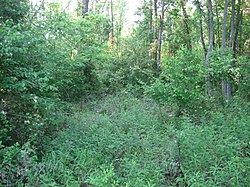Swan's Landing Archeological Site
Swan's Landing Archeological Site (12HR304) | |
 Woods at the site | |
| Location | Mile 658 on the Ohio River[2]: 216 |
|---|---|
| Nearest city | New Amsterdam, Indiana |
| Coordinates | 38°7′54.5″N 86°16′8″W / 38.131806°N 86.26889°W |
| Area | 1.4 acres (0.57 ha) |
| NRHP reference No. | 87000517[1] |
| Added to NRHP | April 2, 1987 |
The Swan's Landing Archeological Site is an
Location
Located along the Ohio River, the site is largely buried by as much as 6 metres (20 ft) of alluvium deposited by the river. It sits at Mile 658 in the river's floodplain, about 3.5 kilometres (2.2 mi) north of the town of New Amsterdam,[2]: 193 and about 6 kilometres (3.7 mi) above the confluence of the Blue River. Measuring about 5 hectares (12 acres) in area, its name is taken from the area's former use by the Swan family as a landing for riverboats along the Ohio.[2]: 194 Nearby terrain features include a dirt road at the site's southern end, a large pond just a stone's throw to the south, and the mouth of Indian Creek about 1,800 metres (5,900 ft) south of the site.[2]: 216
Damage
Local residents became aware of the site by the early 1960s, at which time collectors were finding
Excavations
In the summer of 1986, an archaeological survey was conducted at the site to determine if the site were eligible to be listed on the
Professional surveys in the 1980s revealed a long line of archaeological deposits that was strung out along the riverbank for at least 500 metres (1,600 ft). Types of artifacts found at the site include Kirk cluster projectile points from the
Findings

The massive numbers of stone tools recovered at Swan's Landing indicate that the site was employed as a factory for stone tools from nearby stone outcrops. Some tools were produced at the site,
Recognition
In 1987, Swan's Landing was listed on the National Register of Historic Places because of its archaeological significance.[1] Other manufacturing and reduction sites from the Early Archaic period are known elsewhere in the country, such as the twin Houserville and Tudek Sites in central Pennsylvania,[4] and the artifacts suggest that the people who worked at Swan's Landing were similar to those who lived at the St. Albans Site in West Virginia[2]: 212 and Icehouse Bottom in Tennessee. Regardless of its similarities to these sites, and despite extensive vandalism, the amount of information remaining at Swan's Landing makes it one of the leading Early Archaic sites throughout eastern North America.[2]: 213
See also
References
- ^ a b "National Register Information System". National Register of Historic Places. National Park Service. March 13, 2009.
- ^ a b c d e f g h i j k l m n o p q r s t u Smith, Edward E., Jr. "The Swan's Landing Site (12Hr304): An Early Archaic (Kirk Horizon) Site in Harrison County, South-Central Indiana". Midcontinental Journal of Archaeology 20.2 (1995): 192-238.
- ^ Smith, Edward E. "An Archaeological Assessment of the Swan's Landing Site (12Hr304), Harrison County, Indiana". Bloomington: Glenn A. Black Laboratory of Archaeology, 1986.
- ^ Stevenson, Christopher M., and Conran Hay. National Register of Historic Places Inventory/Nomination: Houserville Site (36CE65). National Park Service, 1980-10-15, 2.
Further reading
- Smith, Edward E. "The Swan's Landing Site: An Early Archaic Lithic Reduction and Tool Manufacturing Site in Harrison County, Indiana". Current Research in the Pleistocene 4 (1987): 71–72.




